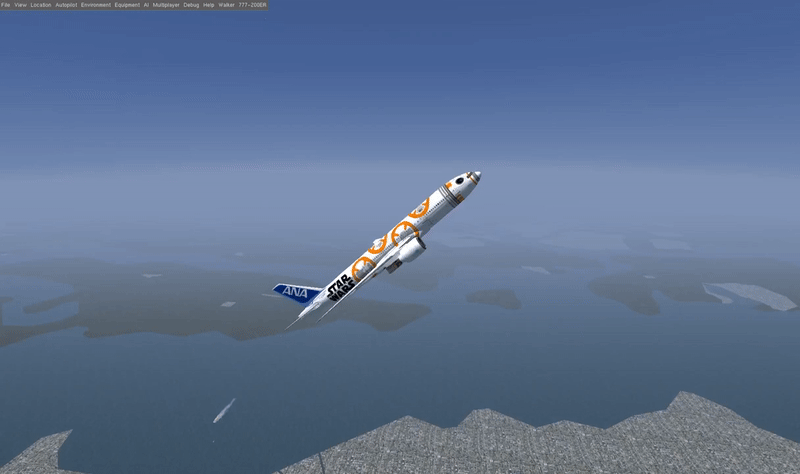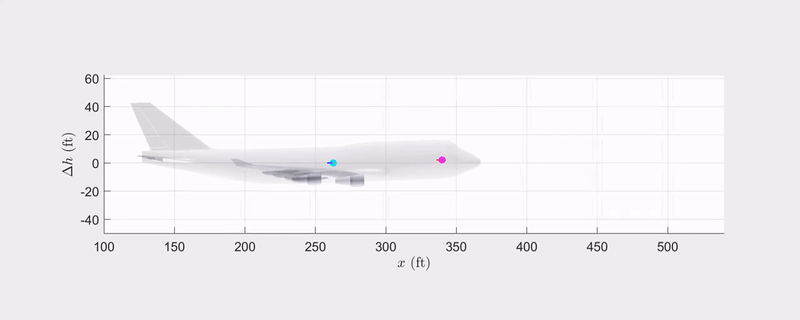Design of Longitudinal Control for Reduced-G Atmospheric Flight
Master Thesis Research, KAUST, RISC Lab, Department of Mechanical Engineering, 2023
This work proposed a triple-integral flight control framework for a zero-gravity flight using a proof-mass-tracking approach. A triple-integral control strategy is adopted to overcome unknown, quadratically increasing drag. Furthermore, to avoid the non-minimum phase characteristics of aircraft longitudinal dynamics (see below), the position deviation from the inertial reference is redefined such that the closed-loop system is minimum phase.

Publication: Chen, Y. H., & Feron, E. (2023). Design of Longitudinal Control for Reduced-Gravity Atmospheric Flights. In AIAA SCITECH 2023 Forum (p. 0218). [Paper Link].
Advisor: Dr. Eric Feron
Motivation
Reduced-G atmospheric flight has attracted great attention from researchers and engineers around the world over past decades. Microgravity environment has a wide range of potential application, such as astronaut training and scientific research in weightlessness or at partial-g levels. Aircraft parabolic flight is a cost-effective way to create weightless or reduced-g conditions in short duration, serving as a tool to investigate phenomena in the absence of gravity. It is expected that microgravity research will become more and more popular as the interests on space and extra-terrestrial planetary exploration increase.
However, the parabolic maneuvers require higher demand for piloting technique, for example, the Airbus A310 Zero G is simultaneously controlled by three members of flight crew, one controls the pitching, the second one controls the rolling to keep the wings level, and the third one is charge of controlling engine thrust and monitoring the flight parameters. Obviously, a well-designed flight control algorithm can improve flight mission safety and efficiency and relieve pilots’ load.
Methodology
A triple-integral control structure is adopted to overcome unknown, quadratically increasing drag. Furthermore, to avoid the non-minimum phase characteristics of aircraft longitudinal dynamics (see below), the position deviation from the inertial reference is redefined such that the closed-loop system is minimum phase. Flight simulations are demonstrated to validate the proposed control strategy and are visualized in the open-source flight simulator FlightGear.

Conclusion
This work aims to develop the flight control algorithm to create a zero-gravity environment using parabolic flight. We presented a longitudinal flight control algorithm to direct the aircraft to achieve zero-gravity through parabolic flights. The controller designed tried to minimize the error between the cockpit and the proof mass that is in the state of free-fall. We proposed a triple-integral control structure to overcome unknown, quadratically increasing drag. Furthermore, to avoid the non-minimum phase characteristics of aircraft longitudinal dynamics, the position deviation from the inertial reference is redefined such that the closed-loop system is minimum phase
Simulation Results
References
[1] J. Afman, E. Feron and J. Hauser, “Nonlinear Maneuver Regulation for Reduced-G Atmospheric Flight,” 2018 IEEE Conference on Decision and Control (CDC), 2018, pp. 731-736, doi: 10.1109/CDC.2018.8618690. (link)
[2] J. Afman, E. Feron and J. Hauser, “Triple-Integral Control for Reduced-G Atmospheric Flight,” 2018 Annual American Control Conference (ACC), 2018, pp. 392-397, doi: 10.23919/ACC.2018.8431251. (link)
[3] Hathaway, Jacob D., and Jamey D. Jacob. “Development of a Microgravity Generating Flight Mode for UAS.” AIAA Modeling and Simulation Technologies Conference. 2016.(link)
[4] Karmali F, Shelhamer M. The dynamics of parabolic flight: flight characteristics and passenger percepts. Acta Astronaut. 2008 Sep;63(5-6):594-602. (link)
[5] Higashino, Shin-ichiro, and Shotaro Kozai. “Automatic microgravity flight system and flight testing using a small unmanned aerial vehicle.” Journal of The Japan Society of Microgravity Application 27.1 (2010): 3. (link)
